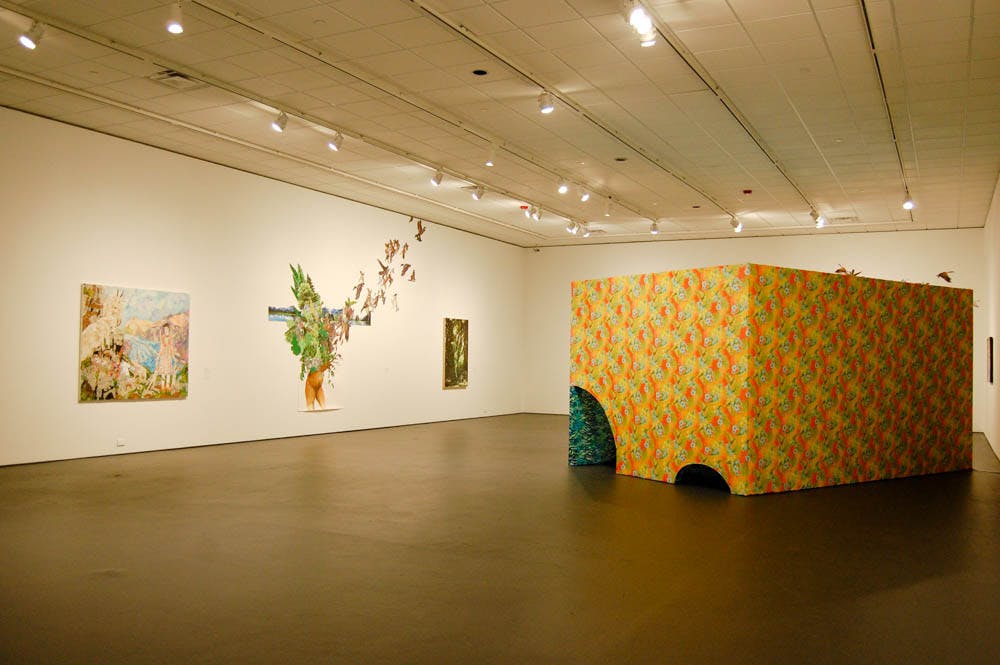“Fertile Ground,” an art exhibit showcasing the complex and layered works of artists María Berrío, Zoë Charlton and Joiri Minaya, opened Aug. 31 at the David Winton Bell Gallery in the List Art Center. The collaborative exhibition was largely orchestrated by Heather Bhandari, guest curator and adjunct lecturer.
“This exhibition … is about how these three artists conceptualize their identities and homelands in relationship to where they are now (in the U.S.),” Bhandari said. “It also dovetails into the conversation many of us are having as U.S. citizens: What does it mean to not be from here?”
The exhibit features an array of vibrant, colorful 2D and 3D art, which Bhandari loosely refers to as “collages,” that feature women in nature. Although united on the same gallery walls and by an overarching theme, each artist’s work reveals their individual personality, heritage and perspective on gendered, cross-cultural power structures through their artistic choices.
Berrío’s work features intricate, lively and surreal collages centered around her upbringing in Bogotá, Colombia. In her works, female subjects meld with the environment to embody the theme of transition and exemplify a partnership between the land and the body.
Charlton’s pieces compile hundreds of stickers, cut paper and gouache to create large-scale figures of women consumed by natural foliage. Paying homage to her grandmother, who was one of the first African-American females to own land in her family, Charlton underscores the duality of how women broke barriers to own property, yet were historically and routinely marked as property, Bhandari explained.
Minaya’s work explores the underlying roots of colonialism and stereotyping behind the tourist industry and associated environments. Hailing from the Dominican Republic, she emphasizes the manipulation and hyper-sexualization of female bodies amidst the tropical Caribbean landscape.
Minaya described her “Container” pieces, which feature photographs of anonymous women wearing tropical-print Spandex bodysuits that force them to strike stereotypical “#dominicanwomen” poses. By portraying the women this way, she emphasized how the women in these photos are often represented as immobile “bodies to be colonized and spaces to be conquered.” Additionally, her “Labadee” video installation narrates the colonialist elements still present within tourist resorts, like one in Haiti from which locals are banned from frequenting. In her work, Minaya exposes how the resort’s seemingly natural landscape is fabricated and “tailored to [the tourists] who can afford it,” as is expressed in written text in the video.
When asked what she most wanted viewers to take away from “Fertile Ground,” Minaya’s answer was simple: “A reconsideration. … An awareness. … A consciousness.” Minaya’s desires for such a reckoning is better understood in the context of the curated works of Berrío, Charlton and Minaya together. In vibrant colors and multimedia installations, the pieces question the historical and current connotations of female and foreign, of body and land, of conquest and colonialism, of then and now. Together, their mediums amass a powerful, three-pronged dialogue on many relevant political conversations that navigate our society today.
Hannah Ponce ’22 was moved by the exhibit upon entering. Referring to Charlton’s work, she said that although “historically African-American women have been depicted in art as the ‘sexy mulatta’ or the ‘masculine mammy,’ Charlton makes a point of defying these cultural tropes by paying homage to their strength ... through explosive natural imagery. It’s powerful.”
Ponce’s realization shows that indeed, Minaya’s wish, a simple, empathetic reconsideration by the viewer, is possible.
The official opening reception of “Fertile Ground” will take place at the Bell Gallery at 5:30 PM, Sept. 13. The exhibit is on display until Nov. 3.
Correction: A previous version of this article stated that Zoë Charlton's piece paid homage to her grandmother, "who was one of the first African-American females to own land in the United States." In fact, her grandmother was one of the first African-American females to own land in her family. The Herald regrets the error.





